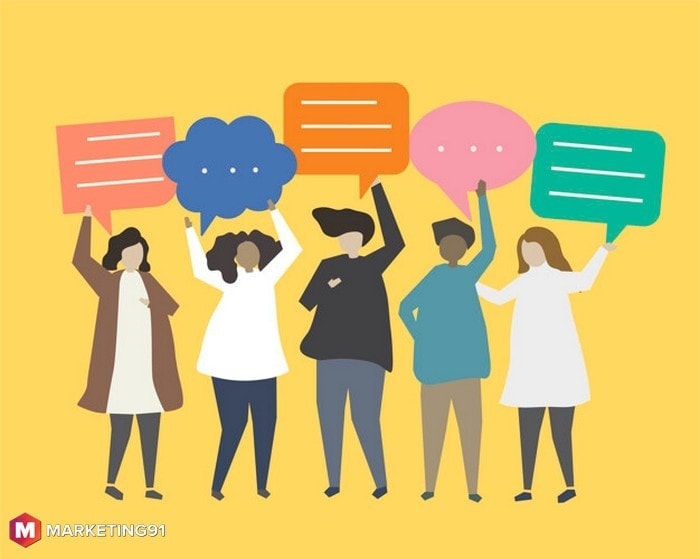
What is Effective Communication? Types, Elements, and Key Differences

Communication is the process of exchanging meaningful messages to convey ideas It involves a sender, message, channel, receiver, feedback, environment, and context Good communication skills can help inform, regulate, socialize, motivate, reduce misunderstanding, make decisions, and solve problems Communication is a two-way, continuous, dynamic, and goal-oriented process that establishes mutual understanding and ensures clarity, transparency, and personalization Good communication has many advantages
Communication is a way by which meaningful messages can be conveyed across people to convey ideas. Any kind of medium may be used by communication to convey the message.
What is Communication?
The act of communication involves comprehending and exchanging significance. The process of communication is not fixed and undergoes continual alterations, making it difficult to define. This implies that any feedback, change in viewpoint or other related modification can have an impact on the current state of affairs. As an illustration, when you commute to work, your process of communication changes due to your altered perspective resulting from interacting with a diverse group of individuals.
Comprehension of written and spoken language is an integral component of communication. To understand means to grasp the meaning or interpretation of a message. Watching a movie with sound and explanation enables better understanding compared to static images devoid of sound or explanation.
Sharing is the final aspect of communication. When an activity is performed in the company of one or more individuals, it can be considered as sharing.
Thus, effective communication involves combining various elements to create a clear and informative exchange of information. This can include conveying messages, thoughts, or ideas to a receiver or group of receivers in a way that they can understand and comprehend.
Importance to Communicate Effectively
Effective communication is the backbone of successful relationships, whether personal or professional. Without it, misunderstandings and conflicts can arise, leading to a breakdown in communication and ultimately, a failure to achieve desired outcomes. It is therefore essential to pay attention to the way we communicate and strive to improve our skills in this area.
Without communication, the process of teaching would come to a halt as there would be no means to convey information through text, pictures, sound, or sign language. The absence of communication would also eliminate the exchange of ideas and thoughts, making it impossible for businesses to survive and individuals to thrive.
Elements of Communication Skills
It is essential to understand the vital components of communication to understand the process of communicating clearly.
Following are eight different components of communication
1. Source
The originator of a message is known as the source. This individual is responsible for initiating and transmitting the message to the intended recipient. For instance, when a person speaks to a group of individuals, they can be viewed as the source of the message.
To convey the message effectively, the source employs both verbal and non-verbal communication techniques.
The transfer of ideas or thoughts from the source to the receiver can involve both written and visual forms of communication. The ultimate goal remains the same, which is to effectively convey the intended message.
2. Message
Visual communication revolves around conveying a message, which is essentially the structured form of communication. This can be achieved through a collection of images that tell a story or a simple arrangement of letters that conveys a specific message. However, it's important to note that the impact of the message is not solely based on the words used, but also on the tone, modulation, and delivery of the message to the recipient.
In different forms of communication, various elements play a significant role. Verbal communication relies on tone and voice modulation, whereas written communication requires proper grammar and punctuation. Meanwhile, non-verbal communication heavily relies on gestures and body language, and visual communication depends on the quality of the images and their settings.
3. Channel
Channels play a crucial role in the process of transmitting messages from one point to another. They act as the medium through which the message travels from the source to the destination. Without channels, it would be impossible to effectively convey the message to the intended recipient. Therefore, channels are an indispensable component of the communication process.
If the message is not transmitted, then the desired action will not be taken, and the communication process will not be valid.
4. Receiver
The recipient is responsible for receiving the message from the sender, acting as the endpoint for the communication process or the starting point for feedback. Depending on the mode of communication, the recipient can observe, perceive, hear, touch, or accurately interpret the message sent by the sender. It is crucial for the sender and recipient to be in sync to comprehend the message effectively. Failure to do so renders the communication ineffective.
There could be many differences between the sender and receiver, and for optimum communication to happen, those differences should be as low as possible.
5. Feedback
Upon receiving the message, the receiver sets out to comprehend and make sense of it. Only once the message is understood, can feedback be provided to the sender. Interestingly, during this exchange, the roles of sender and receiver are reversed as the feedback travels from receiver to sender. This two-way exchange highlights the importance of feedback in communication, as both parties seek to convey their messages to one another.
This feedback will be based on the message which is initially sent from the sender and will be sort of an answer to that message.
6. Environment
When we receive a message, it is within a specific context known as the environment. This context can encompass various elements such as equipment, objects, climate, and anything else present during the communication process. Additionally, the environment in which we engage in face-to-face conversations or communicate with others can also be referred to as the external surroundings.
Every setting has its own unique requirements for appearances, including a packed theatre audience. Whether it's adhering to a dress code for a party or dressing formally for the office, communication is also influenced by the environment. Before communicating, it's important to first understand the environment in which you're operating.
7. Context
Context refers to the environment or situation in which communication occurs. For instance, business meetings and presentations are typically formal, while conversations with family members tend to be more casual. The expectations for behavior and communication style in each setting are often established through environmental cues.
8. Interference
Interference, also known as noise, can hinder effective communication by creating obstacles or blocking the intended message from reaching the receiver. This can result in only a partial understanding of the message or no understanding at all.
When a baby cries in a theatre during the climax of a movie, it can be distracting and prevent the intended message of the film from fully reaching you. However, external noise is not the only type of disturbance that can affect our ability to focus. We also experience internal noise in the form of thoughts that occupy our minds while we are trying to work. This psychological noise can be a major hindrance to productivity, often interrupting our workflow more frequently than we realize. Without these interruptions, we could potentially be ten times more productive than we currently are.
Sometimes, the message may be conveyed to you clearly, but your brain may process it in a different way, resulting in a form of noise. Take for instance an invitation that reads, "Black tie only." If someone were to show up at the event with only a black tie, it would certainly cause a significant disruption.
Functions of Communication Styles
Some of the common functions of communication are…
1. Informing
2. Regulating or Controlling
The informative function of communication is utilized to share and receive information. This function is used to convey informative messages through both verbal and non-verbal communication. It can be applied to various categories of communication.
Communication serves a dual purpose of not only conveying information but also regulating behavior, inclinations and emotions of the participants. The speaker or writer can influence the listener's actions by employing nonverbal cues or signals. Conversely, listeners can also regulate the conversation by signaling the speaker to adjust their approach.
3. Social Interaction
Interpersonal communication plays a crucial role in establishing and nurturing social relationships. It enables individuals to form bonds, develop intimacy, and establish connections with both internal and external stakeholders of an organization, such as employees, leaders, suppliers, investors, and customers.
4. Motivating or Persuading
5. Reducing Misunderstanding
Effective communication is not just about conveying information, it is also about motivating, persuading, or influencing others with your thoughts. This is especially important in the field of business management, where managers and leaders must possess strong communication skills to inspire and motivate their teams towards achieving common goals.
Effective communication is essential in minimizing confusion, conflicts, misunderstandings, and controversies in any organization. Adopting a system of upward and downward communication can help resolve various issues, disputes, and disagreements.
6. Decision/Choice Making
Communication plays a vital role in enabling effective decision-making, both in personal and professional spheres. It facilitates the exchange of information and perspectives, which in turn empowers the decision-making process. Whether it's managers, leaders, or employees at lower levels, everyone leverages communication practices to participate in decision-making.
7. Solving Problems/Troubles
Communication can be the key to overcoming the various obstacles we encounter in our personal and professional lives. By effectively expressing our concerns and issues with the relevant parties, we can work towards finding the best possible solutions. This approach also ensures that there is no room for misinterpretation or bias when addressing any problems that may arise.
Nature of Communication
A communication process may have the following nature.
1. Two-way process
Communication revolves around a two-way process in which at least a sender and a receiver participate, as one individual will not be able to communicate with himself.
2. Verbal and non-verbal
One of the key characteristics of effective communication is its dual nature of being both verbal and nonverbal. Verbal communication involves the use of words to convey information, while nonverbal communication relies on body language, gestures, and postures to express emotions.
3. Continuous process
The exchange of ideas and opinions is a crucial aspect of the communication process, which involves continuous interactions that facilitate discussions and decision-making.
4. Goal-oriented
Effective communication is characterized by its ability to help participants achieve their intended objectives, making goal orientation a crucial aspect of any successful communication session.
5. A Medium, not an end
Communication serves as a conduit for sharing information between individuals, but it is not the ultimate objective. Rather, communication serves as a tool or mechanism for achieving goals and reaching desired outcomes.
6. Mutual understanding
Communication sets the ground for mutual understanding. Participants of a communication process develop a mutual understanding of the shared topic, subject, or message.
7. Dynamic process
Human communication is a constantly evolving process that adapts to the needs and preferences of both sender and receiver. As such, it can take on a variety of forms and be transmitted through various mediums, making it a truly dynamic phenomenon.
8. Exchange
Communication is essentially the act of sharing information, thoughts, and emotions with others in order to achieve mutual understanding. It involves a two-way process where both parties engage in a dialogue to develop a deeper understanding of each other's perspectives.
9. Pervasive
Communication is also ubiquitous as it is present everywhere. It takes place at different levels of professional, personal, or organizational structure.
10. Foundation of management
Effective communication is essential for successfully managing various professional activities, including organizational planning and development. It serves as a critical element in channelizing all managerial functions.
11. Inter-disciplinary
Effective communication involves gathering knowledge and information from various fields, including anthropology (which studies body language), psychology (which studies attitude), sociology (which studies human behavior), and more. By utilizing this knowledge and information, communication can become more empowered and effective. Check out this video on communication for more insights.
Features of communication
1. Communication takes place between at least two or more people
Effective communication hinges on the individuals involved in the exchange. Typically, communication occurs between two or more people, with one person serving as the recipient of information and the other as the transmitter. Yet, it's important to note that communication is a two-way street, allowing both parties to share information simultaneously.
2. A two-way process
As we have learned already that communication is a two-way process where all parties involved in the communication process exchange ideas and information with one another.
However, communication is not complete unless the message is not understood and acknowledged by the receiver of the message.
3. The message
Communication devoid of a useful message is futile. Hence, a message becomes an indispensable component of the communication and writing process. A message can take the form of an idea, information, instructions, or suggestions.
A communication is called effective if it delivers the intended message properly, and there will be no communication with no message.
4. Dynamic in nature
Communication is a fluid process that develops and transforms with the engagement and mindset of those involved. As a result, the duration of communication can vary greatly, from brief exchanges to lengthy conversations, based on the relevance of the conveyed information and the level of engagement from all parties.
For example, a meeting between the manager and his subordinates can last for 10 minutes or can also last for hours, depending on the discussion taking place in the meeting.
5. Establish mutual Understanding
It is crucial for communication to facilitate mutual comprehension among the parties engaged in the process. This implies that the receiver must receive and interpret the information in line with the sender's intended meaning. Without the proper conveyance of messages and the receipt of acknowledgment by the sender, effective communication cannot be achieved.
6. Response
Communication will be considered complete only if the appropriate response is received by the sender of the message.
7. Systematic
Every aspect of communication is interconnected, implying that any modification in one component can significantly impact the overall meaning of the communication. Consider a scenario where a superior communicates with a subordinate over the phone. Even the slightest glitch in the phone line can cause a disruption in the information exchange during the communication process.
8. Form of communication
Communication can manifest itself in various forms. It can be verbal, written, or nonverbal. Verbal and written communication are typically seen as formal and are commonly used in professional settings. Nonverbal communication, on the other hand, relies on gestures and eye contact to convey information.
It is an informal type of communication which is widely used in the informal environment but is not acceptable and considered appropriate in the formal environment.
9. The flow of information
Communication within an organization can occur between a superior and their subordinates, with information flowing both ways. Additionally, communication can also occur between individuals working at the same level, known as side-to-side communication. Both up-to-down and side-to-side communication can be formal or informal.
Formal communication refers to the exchange of information through established channels within an organization, while informal communication occurs through unofficial means such as gossip or casual conversation. An employee sharing information from a circular with a colleague would fall under the category of formal communication, whereas spreading rumors about a coworker would be considered informal communication.
10. A continuous Process
Communication is an ongoing process that involves the exchange of information between individuals without end. To illustrate, a manager may provide directives to their subordinates, such as models, to carry out various tasks in the workplace.
Role of Communication
An effective leader understands the crucial role of communication in driving productivity within their organization. They possess the ability to effectively communicate with their team members, and this skill is essential for any successful organization. The following qualities are necessary for effective communication and for a leader to be an effective communicator:
1. Ensuring Clarity of Message Delivery
All effective communication methods are easy and straightforward. They are subtly clear and concise with the organization’s work.
Clear and concise communication is crucial for effective leadership. Avoid any misunderstandings by communicating your messages and views with full clarity. Ensure that every person on the team understands the goals and objectives of the project. It is the responsibility of team leaders to provide this clarity. When making decisions about the project, it is important to ask clear questions such as the duration and timeline for completion. Vague and incomplete communication can lead to unproductive stages within the organization.
2. Communication to establish personalization
To communicate with everyone in the room is a tedious task. But an effective leader knows that everyone is essential in the room and has a voice.
By taking the time to get to know each team member on a personal level, this individual is able to establish a level of trust and confidence with them. This, in turn, allows for more effective communication and encourages employees to share their thoughts and ideas with their leaders or managers.
3. Ensuring transparency in work
Effective communication requires transparency, a key trait for any leader within an organization. It is important for leaders to be transparent in all their actions, as their fellow employees are closely observing their every move without any barriers.
The transparent nature of the leader allows for all employees to have visibility into the various working processes. There are no hidden agendas, and employees do not need to read between the lines as everything is communicated with clarity and specificity.
The deprivation of transparency leads to uncertain situations in the organization. This causes distrust and anxiety within the organization.
4. Listening to everyone and feedback system
The process of communication involves both the sender and receiver of a message. In a team setting, leaders take the time to listen to each team member's perspective to work towards achieving organizational goals. By fostering effective communication, relationships among coworkers can be strengthened, resulting in improved accuracy and clarity in work.
Great leaders prioritize the analysis of messages before reaching any conclusions. They take accountability for every process and quickly rectify any mistakes to prevent significant losses for the organization. They do so with a level-headed approach, without resorting to exaggerated drama or false humility.
5. Offering the ability to inspire
It is the most vital element of effective communication. In this, the influential leaders have to inspire their teammates to that level to perform exceptionally well.
Effective leaders possess a clear vision of success that guides the organization towards its goals. Crucially, it is the leader's responsibility to effectively communicate and motivate all team members to perform at their best.
Outstanding communication skills are essential for successful leadership and can greatly enhance an organization's productivity and profitability.
Advantages of Good Communication
Effective communication is a crucial aspect of successful leadership as it significantly improves organizational performance. The benefits of clear and consistent communication within a workplace are numerous, with increased employee efficiency being one of the most notable. When communication is done well, employees are equipped with all the necessary information and knowledge to carry out their tasks effectively, thus enhancing overall productivity and success.
Efficient communication is crucial for boosting an organization's business performance as it impacts various aspects of the business. From public relations to marketing, effective communication is essential to convey the message to customers and achieve business goals.
Through effective communication, leaders can effectively reach their target market by sharing engaging narratives that highlight the value of their products and services to their current customers.
Conclusion
: By understanding the importance of communication and actively practicing effective communication, individuals can improve their personal and professional relationships and achieve success in various aspects of life. It is crucial to recognize the power of language and nonverbal cues in conveying messages and building connections with others. By being aware of our own communication style and adapting to the needs of different situations and individuals, we can foster positive and meaningful interactions.
Objectives Of Communication




















